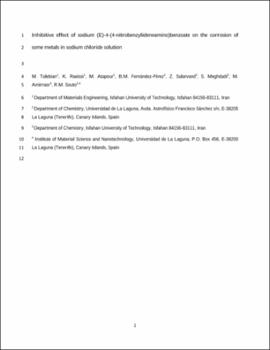Inhibitive effect of sodium (E)-4-(4-nitrobenzylidenamino) benzoate on the corrosion of some metals in sodium chloride solution
Date
2018Abstract
The inhibition performance of a novel anionic carboxylic Schiff base, sodium (E)-4-(4-nitrobenzylideneamino)benzoate (SNBB), was investigated for various metals, namely low carbon steel F111, pure iron and copper, in neutral 10 mM NaCl solution. Potentiodynamic polarization, scanning vibrating electrode technique (SVET), quantum chemical (QC) calculation, and molecular dynamics (MD) simulation were employed. The potentiodynamic polarization data showed that SNBB acts as an effective corrosion inhibitor for both iron and F111 steel, but it is not effective for the copper. In situ spatially-resolved SVET maps evidenced a major change in surface reactivity for Fe and F111 steel immersed in 10 mM aqueous solution in the absence and in the presence of SNBB. Featureless ionic current density distributions were recorded in the presence of SNBB at both their spontaneous open circuit potential (OCP) and under mild anodic polarization conditions, while major ionic flows were monitored above the metals in the absence of SNBB. On the basis of computer simulations, it is proposed that SNBB produces a stable chelate film on iron and steel surfaces that accounts for the good corrosion inhibition efficiency observed. The different inhibition efficiencies of SNBB molecules on the iron and copper was attributed to the special chemical structure of SNBB molecule and its different chelation ability with the released metal ions on the metal surface. The QC calculations also confirmed the high corrosion inhibition efficiency of SNBB. The MD simulation indicated higher binding energy of SNBB on iron surface compared to that of copper surface. The interaction mode of SNBB on iron and F111 steel surfaces corresponds to a mixed chemical and physical adsorption, and it obeys the Langmuir isotherm






